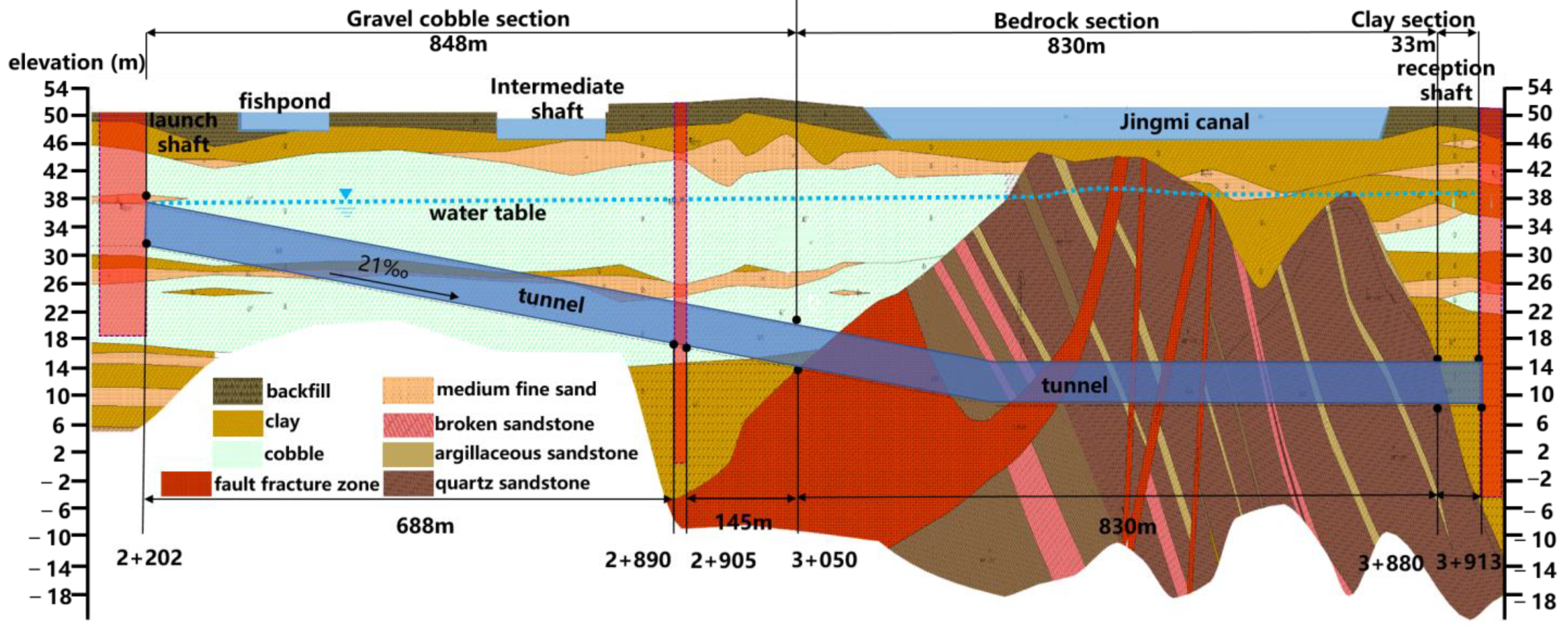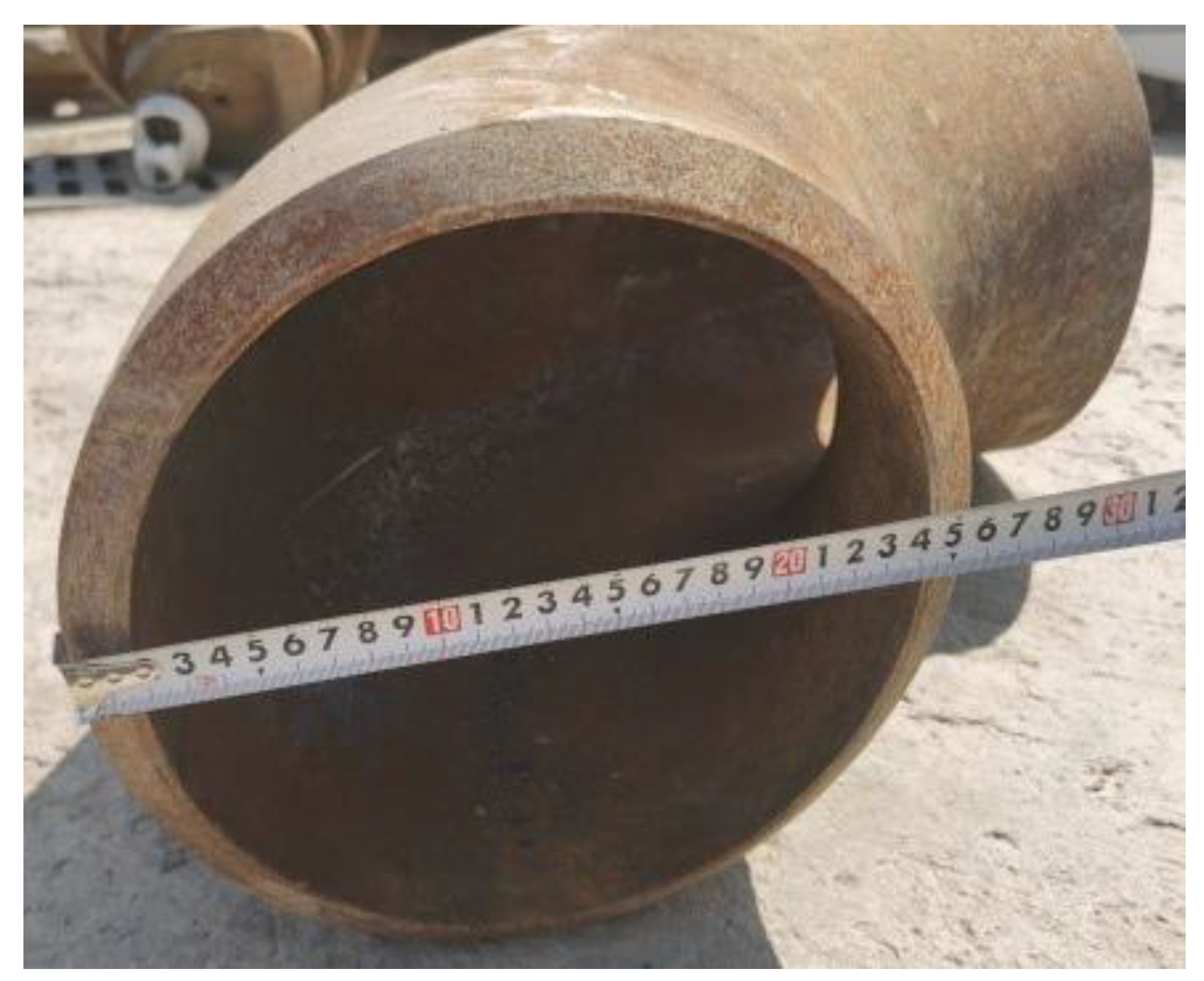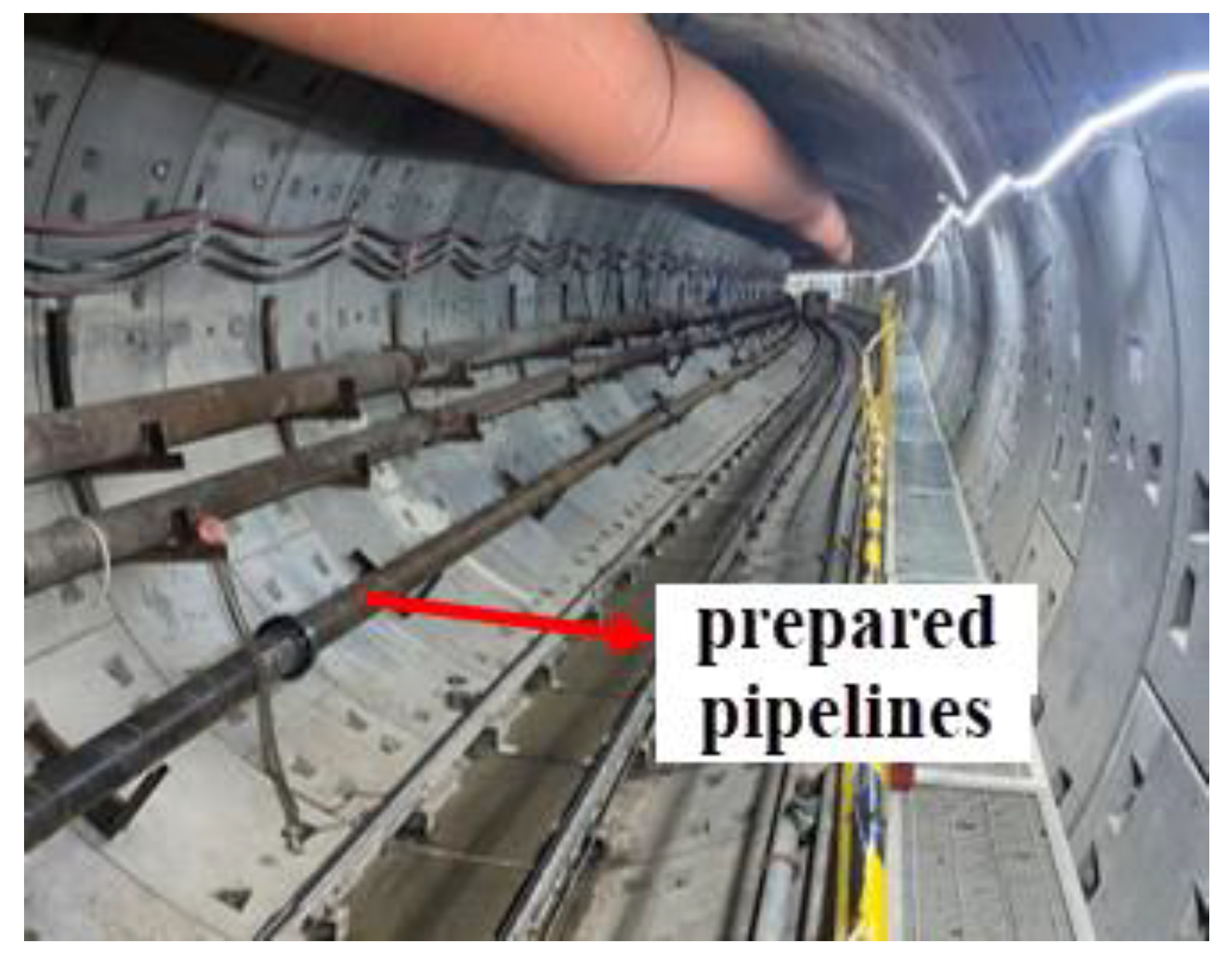Slurry Discharge Pipeline Damage and Wear Due to Transporting Rock Particles during Slurry Shield Tunneling: A Case Study Based on In Situ Observed Results
Abstract
:1. Introduction
2. Project Overview
3. Large Rock Particles and Flow Rate of the Carrier Slurry
4. Damage and Wear of Components of the Slurry Transportation System
4.1. Failure of Horizontal Straight Pipe
4.2. Failure of Knife Gate Valves
4.3. Failure of the Slurry Pump
4.4. Failure of the Elbows/Bends
5. Countermeasures Taken against Pipeline Damage and Wear
5.1. Monitoring the Wear of Pipelines
5.2. Countermeasures Taken for the Pipeline
5.2.1. Mounting Method of the Pipeline in the Existing Tunnel
5.2.2. Application of Wear-Resistant Elbows/Bends
5.2.3. Welding Reinforcement Plates to Bends in Advance
5.2.4. Rotating Straight Pipes 180 Degrees for Reuse
5.2.5. Preparing Additional Pipes Beforehand
6. Discussion
6.1. Pipeline Damage and Wear
6.2. Effect of Pipeline Arrangement and Fixation
6.3. Pipeline Leaks When Tunneling in Different Ground
7. Conclusions
- (1)
- Controlled by the movement of the transported rock particles, damage and wear mainly occurred at the bottom wall of the pipeline. Compared with straight pipes, elbows/bends were more easily worn out. Inclined straight pipes had a higher wear rate than horizontal straight pipes. Pipes installed along curved tunnels suffered more wear than those in straight tunnels. The reduction in slurry velocity reduced pipe wear, while sharp particle shapes increased wear, and the shape of the particles had a greater impact.
- (2)
- The measured results showed that the wear rates of the straight pipe, pipe along the curved tunnel, 60° inclined pipe, and 90° elbow pipe in pebble ground were approximately 0.71 mm/100 rings, 1 mm/100 rings, 2.14 mm/100 rings, and 4 mm/100 rings, respectively. After segment ring 705, the machine drove into rock ground, and the wear rates increased by one to two times, which could be attributed to the rock particles of the pebble layer being polished and the rock fragmentations in the rock ground having sharp edges.
- (3)
- The arrangement of the pipeline should favor pipeline inspection and maintenance. Because of the insufficient space to repair the worn-out bottom walls of the pipeline, the slurry discharge pipeline should not be mounted on the tunnel floor. Additionally, pipelines should be tightly fixed to reduce their movement.
- (4)
- To fight pipeline wear and leaks and maintain sustained shield tunneling, countermeasures should be planned and prepared beforehand. First, the layout of pipelines in an existing tunnel should favor pipeline maintenance and repair. Second, for long tunnel projects, preparing a slurry discharge pipeline system ready for use is suggested, especially at the rear half of the tunnel. Third, wear-resistant elbows/bends should be used, and reinforcement plates should be welded to them in advance to prevent the occurrence of leaks. Other measures, such as rotating a worn pipe 180 degrees for reuse and exchanging slurry feed lines and slurry discharge lines, are also proposed.
Author Contributions
Funding
Institutional Review Board Statement
Informed Consent Statement
Data Availability Statement
Acknowledgments
Conflicts of Interest
References
- Min, F.; Zhu, W.; Han, X. Filter cake formation for slurry shield tunneling in highly permeable sand. Tunn. Undergr. Space Technol. 2013, 38, 423–430. [Google Scholar] [CrossRef]
- Summer, R.M. A Review of Pipeline Slurry Erosion Measurements and Research Recommendations; ASTM International: West Conshohocken, PA, USA, 1987; pp. 91–100. [Google Scholar]
- Hutchings, I.M. Mechanisms of wear in powder technology: A review. Powder Technol. 1993, 76, 3–13. [Google Scholar] [CrossRef]
- Gupta, R.; Singh, S.N.; Sehadri, V. Prediction of uneven wear in a slurry pipeline on the basis of measurements in a pot tester. Wear 1995, 184, 169–178. [Google Scholar] [CrossRef]
- Gandhi, B.K.; Singh, S.N.; Seshadri, V. Study of the parametric dependence of erosion wear for the parallel flow of solid–liquid mixtures. Tribol. Int. 1999, 32, 275–282. [Google Scholar] [CrossRef]
- Yabuki, A.; Matsumura, M. Theoretical equation of the critical impact velocity in solid particles impact erosion. Wear 1999, 233, 476–483. [Google Scholar] [CrossRef]
- Oka, Y.I.; Okamura, K.; Yoshida, T. Practical estimation of erosion damage caused by solid particle impact: Part 1: Effects of impact parameters on a predictive equation. Wear 2005, 259, 95–101. [Google Scholar] [CrossRef]
- Oka, Y.I.; Yoshida, T. Practical estimation of erosion damage caused by solid particle impact: Part 2: Mechanical properties of materials directly associated with erosion damage. Wear 2005, 259, 102–109. [Google Scholar] [CrossRef]
- Pereira, G.C.; de Souza, F.J.; de Moro Martins, D.A. Numerical prediction of the erosion due to particles in elbows. Powder Technol. 2014, 261, 105–117. [Google Scholar] [CrossRef]
- Arabnejad, H.; Mansouri, A.; Shirazi, S.A.; McLaury, B.S. Development of mechanistic erosion equation for solid particles. Wear 2015, 332, 1044–1050. [Google Scholar] [CrossRef]
- Rawat, A.; Singh, S.N.; Seshadri, V. Erosion wear studies on high concentration fly ash slurries. Wear 2017, 378, 114–125. [Google Scholar] [CrossRef]
- Coker, E.H.; Van Peursem, D. The erosion of horizontal sand slurry pipelines resulting from inter-particle collision. Wear 2018, 400, 74–81. [Google Scholar] [CrossRef]
- Javaheri, V.; Porter, D.; Kuokkala, V.T. Slurry erosion of steel—Review of tests, mechanisms and materials. Wear 2018, 408, 248–273. [Google Scholar] [CrossRef]
- Singh, V.; Kumar, S.; Mohapatra, S.K. Modeling of erosion wear of sand water slurry flow through pipe bend using CFD. J. Appl. Fluid Mech. 2019, 12, 679–687. [Google Scholar] [CrossRef]
- Huard, M.; Adane, K.F. Validation of a Dense Slurry Pipeline Erosion-Corrosion Model. In Proceedings of the CORROSION 2020, Houston, TX, USA, 14–18 June 2020. [Google Scholar]
- Singh, J. A Review on Mechanisms and Testing of Wear in Slurry Pumps, Pipeline Circuits, and Hydraulic Turbines. J. Tribol. 2021, 143, 090801. [Google Scholar] [CrossRef]
- Pak, Y.T.; Kim, T.K.; Ko, T.Y. A study on the discharge pipes wear of slurry shield TBM in rock strata. J. Korean Tunn. Undergr. Space Assoc. 2017, 19, 57–70. [Google Scholar] [CrossRef] [Green Version]
- Ko, T.Y.; Pak, Y.T.; Yoon, D.H.; Kim, S.; Kim, T.K. Slurry pipe wear in shield TBM. In Proceedings of the YSRM 2017—The 4th ISRM Young Scholars’ Symposium on Rock Mechanics and NDRM 2017—The 5th International Symposium on New Development in Rock Engineering—An ISRM Specialised Conference, Jeju, Republic of Korea, 11–13 May 2017; pp. 458–460. [Google Scholar]
- Ko, T.Y.; Pak, Y.T.; Kim, T.K.; Son, S.M. Effect of rock abrasiveness on slurry shield tunneling. In Proceedings of the International Conference on Tunnel Boring Machines in Difficult Grounds (TBM DiGs), Wuhan, China, 20–22 November 2017; pp. 1–8. [Google Scholar]
- Ko, T.Y.; Lee, S.S. Effect of rock abrasiveness on wear of shield tunnelling in bukit timah granite. Appl. Sci. 2020, 10, 3231. [Google Scholar] [CrossRef]
- Dong, B. Countermeasures for reducing wear and vibration of slurry pipe of slurry shield. Tunn. Constr. 2016, 36, 1385–1388. (In Chinese) [Google Scholar]
- Wang, F. The difficulties and countermeasures in shield construction of Yellow River tunnel of Lanzhou Metro Line 1. Railw. Stand. Design 2017, 61, 93–99. (In Chinese) [Google Scholar]
- Huang, B.; Li, X.; Chen, C. Study of abrasion of slurry pipe of large-diameter slurry shield boring in complex strata. Tunn. Constr. 2016, 36, 490–496. (In Chinese) [Google Scholar]
- Hou, B.; Xu, Z.; Hu, X.; Guo, G. Analysis of technical difficulties and control measures for slurry shield boring in sandy cobble strata: A case study of Yellow River crossing tunnel of Lanzhou Metro. Tunn. Constr. 2018, 38, 846–850. (In Chinese) [Google Scholar]





















| Steel Grade | C | Mn | Si (≤) | S (≤) | P (≤) | Cu (≤) | Cr (≤) | Ni (≤) |
|---|---|---|---|---|---|---|---|---|
| Q235B | 0.12~0.20% | 0.30~0.70% | 0.30% | 0.045% | 0.045% | 0.30% | 0.30% | 0.30% |
| Time | Number of Leaks | Finished Segment Rings per Month | Damage Ratio | Ground Type |
|---|---|---|---|---|
| July 2020 | 15 | 156 | 9.62% | Cobble layer |
| August 2020 | 13 | 176 | 7.39% | Cobble layer |
| September 2020 | 5 | 30 | 16.67% | Cobble layer |
| October 2020 | 0 | 15 | 0.00% | Cobble layer |
| December 2020 | 2 | 64 | 3.12% | Cobble layer |
| December 2020 | 5 | 95 | 5.26% | Rock ground/fault fracture zone |
| November 2020 | 17 | 89 | 19.10% | Rock ground/fault fracture zone |
| January 2021 | 14 | 77 | 18.18% | Rock ground/fault fracture zone |
| February 2021 | 6 | 74 | 8.11% | Rock ground/fault fracture zone |
| March 2021 | 20 | 89 | 22.47% | Rock ground/fault fracture zone |
| April 2021 | 36 | 61 | 59.02% | Rock ground/sandstone and quartz sandstone |
| May 2021 | 10 | 15 | 66.67% | Rock ground/sandstone and quartz sandstone |
| In total | 143 | 941 | 15.20% | - |
Disclaimer/Publisher’s Note: The statements, opinions and data contained in all publications are solely those of the individual author(s) and contributor(s) and not of MDPI and/or the editor(s). MDPI and/or the editor(s) disclaim responsibility for any injury to people or property resulting from any ideas, methods, instructions or products referred to in the content. |
© 2023 by the authors. Licensee MDPI, Basel, Switzerland. This article is an open access article distributed under the terms and conditions of the Creative Commons Attribution (CC BY) license (https://creativecommons.org/licenses/by/4.0/).
Share and Cite
Li, X.; Fang, Y.; Guo, Y.; Li, X. Slurry Discharge Pipeline Damage and Wear Due to Transporting Rock Particles during Slurry Shield Tunneling: A Case Study Based on In Situ Observed Results. Appl. Sci. 2023, 13, 7103. https://doi.org/10.3390/app13127103
Li X, Fang Y, Guo Y, Li X. Slurry Discharge Pipeline Damage and Wear Due to Transporting Rock Particles during Slurry Shield Tunneling: A Case Study Based on In Situ Observed Results. Applied Sciences. 2023; 13(12):7103. https://doi.org/10.3390/app13127103
Chicago/Turabian StyleLi, Xinggao, Yingran Fang, Yidong Guo, and Xingchun Li. 2023. "Slurry Discharge Pipeline Damage and Wear Due to Transporting Rock Particles during Slurry Shield Tunneling: A Case Study Based on In Situ Observed Results" Applied Sciences 13, no. 12: 7103. https://doi.org/10.3390/app13127103
APA StyleLi, X., Fang, Y., Guo, Y., & Li, X. (2023). Slurry Discharge Pipeline Damage and Wear Due to Transporting Rock Particles during Slurry Shield Tunneling: A Case Study Based on In Situ Observed Results. Applied Sciences, 13(12), 7103. https://doi.org/10.3390/app13127103





